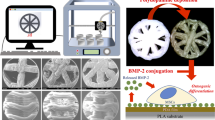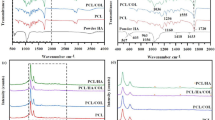Abstract
Since 3D printed hard materials could match the shape of bone, cell survival and fate determination towards osteoblasts in such materials have become a popular research target. In this study, a scaffold of hard material for 3D fabrication was designed to regulate developmental signal (Notch) transduction guiding osteoblast differentiation. We established a polycaprolactone (PCL) and cell-integrated 3D printing system (PCI3D) to reciprocally print the beams of PCL and cell-laden hydrogel for a module. This PCI3D module holds good cell viability of over 87%, whereas cells show about sixfold proliferation in a 7-day culture. The osteocytic MLO-Y4 was engineered to overexpress Notch ligand Dll4, making up 25% after mixing with 75% stromal cells in the PCI3D module. Osteocytic Dll4, unlike other delta-like family members such as Dll1 or Dll3, promotes osteoblast differentiation and the mineralization of primary mouse and a cell line of bone marrow stromal cells when cultured in a PCI3D module for up to 28 days. Mechanistically, osteocytic Dll4 could not promote osteogenic differentiation of the primary bone marrow stromal cells (BMSCs) after conditional deletion of the Notch transcription factor RBPjκ by Cre recombinase. These data indicate that osteocytic Dll4 activates RBPjκ-dependent canonical Notch signaling in BMSCs for their oriented differentiation towards osteoblasts. Additionally, osteocytic Dll4 holds a great potential for angiogenesis in human umbilical vein endothelial cells within modules. Our study reveals that osteocytic Dll4 could be the osteogenic niche determining cell fate towards osteoblasts. This will open a new avenue to overcome the current limitation of poor cell viability and low bioactivity of traditional orthopedic implants.
Graphic abstract









Similar content being viewed by others
References
Turnbull G, Clarke J, Picard F et al (2018) 3D bioactive composite scaffolds for bone tissue engineering. Bioact Mater 3(3):278–314. https://doi.org/10.1016/j.bioactmat.2017.10.001
Fan J, Lee CS, Kim S et al (2021) Trb3 controls mesenchymal stem cell lineage fate and enhances bone regeneration by scaffold-mediated local gene delivery. Biomaterials 264:120445. https://doi.org/10.1016/j.biomaterials.2020.120445
Amini AR, Laurencin CT, Nukavarapu SP (2012) Bone tissue engineering: recent advances and challenges. Crit Rev Biomed Eng 40(5):363–408. https://doi.org/10.1615/critrevbiomedeng.v40.i5.10
Borciani G, Montalbano G, Baldini N et al (2020) Co-culture systems of osteoblasts and osteoclasts: simulating in vitro bone remodeling in regenerative approaches. Acta Biomater 108:22–45. https://doi.org/10.1016/j.actbio.2020.03.043
Kang HW, Lee SJ, Ko IK et al (2016) A 3D bioprinting system to produce human-scale tissue constructs with structural integrity. Nat Biotechnol 34(3):312–319. https://doi.org/10.1038/nbt.3413
Malda J, Groll J (2016) A step towards clinical translation of biofabrication. Trends Biotechnol 34(5):356–357. https://doi.org/10.1016/j.tibtech.2016.03.003
Lieben L (2016) Regenerative medicine: the future of 3D printing of human tissues is taking shape. Nat Rev Rheumatol 12(4):191. https://doi.org/10.1038/nrrheum.2016.29
Murphy C, Kolan K, Li W, et al., (2017) 3D bioprinting of stem cells and polymer/bioactive glass composite scaffolds for bone tissue engineering. Int J Bioprint 3(1):53–63. https://doi.org/10.18063/IJB.2017.01.005
Piard C, Baker H, Kamalitdinov T et al (2019) Bioprinted osteon-like scaffolds enhance in vivo neovascularization. Biofabrication 11(2):025013. https://doi.org/10.1088/1758-5090/ab078a
Choudhury D, Tun HW, Wang T et al (2018) Organ-derived decellularized extracellular matrix: a game changer for bioink manufacturing? Trends Biotechnol 36(8):787–805. https://doi.org/10.1016/j.tibtech.2018.03.003
Swetha S, Lavanya K, Sruthi R et al (2020) An insight into cell-laden 3D-printed constructs for bone tissue engineering. J Mater Chem B 8(43):9836–9862. https://doi.org/10.1039/d0tb02019b
Hao Z, Song Z, Huang J et al (2017) The scaffold microenvironment for stem cell based bone tissue engineering. Biomater Sci 5(8):1382–1392. https://doi.org/10.1039/c7bm00146k
Liang X, Gao J, Xu W et al (2019) Structural mechanics of 3D-printed poly(lactic acid) scaffolds with tetragonal, hexagonal and wheel-like designs. Biofabrication 11(3):035009. https://doi.org/10.1088/1758-5090/ab0f59
Gao J, Ding X, Yu X et al (2021) Cell-free bilayered porous scaffolds for osteochondral regeneration fabricated by continuous 3D-printing using nascent physical hydrogel as ink. Adv Healthc Mater 10(3):e2001404. https://doi.org/10.1002/adhm.202001404
Confalonieri D, Schwab A, Walles H et al (2018) Advanced therapy medicinal products: a guide for bone marrow-derived MSC application in bone and cartilage tissue engineering. Tissue Eng Part B Rev 24(2):155–169. https://doi.org/10.1089/ten.TEB.2017.0305
Moreno Madrid AP, Vrech SM, Sanchez MA et al (2019) Advances in additive manufacturing for bone tissue engineering scaffolds. Mater Sci Eng C Mater Biol Appl 100:631–644. https://doi.org/10.1016/j.msec.2019.03.037
Rohban R, Pieber TR (2017) Mesenchymal stem and progenitor cells in regeneration: tissue specificity and regenerative potential. Stem Cells Int 2017:5173732. https://doi.org/10.1155/2017/5173732
Gigante A, Manzotti S, Bevilacqua C et al (2008) Adult mesenchymal stem cells for bone and cartilage engineering: effect of scaffold materials. Eur J Histochem 52(3):169–174. https://doi.org/10.4081/1208
Niedzwiedzki T, Filipowska J (2015) Bone remodeling in the context of cellular and systemic regulation: the role of osteocytes and the nervous system. J Mol Endocrinol 55(2):R23–R36. https://doi.org/10.1530/JME-15-0067
Robling AG, Bonewald LF (2020) The osteocyte: new insights. Annu Rev Physiol 82:485–506. https://doi.org/10.1146/annurev-physiol-021119-034332
Tu X, Delgado-Calle J, Condon KW et al (2015) Osteocytes mediate the anabolic actions of canonical Wnt/beta-catenin signaling in bone. Proc Natl Acad Sci USA 112(5):E478–E486. https://doi.org/10.1073/pnas.1409857112
Bai S, Kopan R, Zou W et al (2008) NOTCH1 regulates osteoclastogenesis directly in osteoclast precursors and indirectly via osteoblast lineage cells. J Biol Chem 283(10):6509–6518. https://doi.org/10.1074/jbc.M707000200
Engin F, Yao Z, Yang T et al (2008) Dimorphic effects of Notch signaling in bone homeostasis. Nat Med 14(3):299–305. https://doi.org/10.1038/nm1712
Hilton MJ, Tu X, Wu X et al (2008) Notch signaling maintains bone marrow mesenchymal progenitors by suppressing osteoblast differentiation. Nat Med 14(3):306–314. https://doi.org/10.1038/nm1716
Han H, Tanigaki K, Yamamoto N et al (2002) Inducible gene knockout of transcription factor recombination signal binding protein-J reveals its essential role in T versus B lineage decision. Int Immunol 14(6):637–645. https://doi.org/10.1093/intimm/dxf030
Tu X, Joeng KS, Nakayama KI et al (2007) Noncanonical Wnt signaling through G protein-linked PKCdelta activation promotes bone formation. Dev Cell 12(1):113–127. https://doi.org/10.1016/j.devcel.2006.11.003
Stern AR, Stern MM, Van Dyke ME et al (2012) Isolation and culture of primary osteocytes from the long bones of skeletally mature and aged mice. Biotechniques 52(6):361–373. https://doi.org/10.2144/0000113876
Billiet T, Gevaert E, De Schryver T et al (2014) The 3D printing of gelatin methacrylamide cell-laden tissue-engineered constructs with high cell viability. Biomaterials 35(1):49–62. https://doi.org/10.1016/j.biomaterials.2013.09.078
Venugopal JR, Giri Dev VR, Senthilram T et al (2011) Osteoblast mineralization with composite nanofibrous substrate for bone tissue regeneration. Cell Biol Int 35(1):73–80. https://doi.org/10.1042/CBI20090066
Zhang Q, Lu S, Li T et al (2019) ACE2 inhibits breast cancer angiogenesis via suppressing the VEGFa/VEGFR2/ERK pathway. J Exp Clin Cancer Res 38(1):173. https://doi.org/10.1186/s13046-019-1156-5
Daly AC, Freeman FE, Gonzalez-Fernandez T et al (2017) 3D Bioprinting for cartilage and osteochondral tissue engineering. Adv Healthc Mater 6(22):1700298. https://doi.org/10.1002/adhm.201700298
Majidinia M, Sadeghpour A, Yousefi B (2018) The roles of signaling pathways in bone repair and regeneration. J Cell Physiol 233(4):2937–2948. https://doi.org/10.1002/jcp.26042
Zohorsky K, Mequanint K (2021) Designing biomaterials to modulate Notch signaling in tissue engineering and regenerative medicine. Tissue Eng Part B Rev 27(5):383–410. https://doi.org/10.1089/ten.TEB.2020.0182
Rao SH, Harini B, Shadamarshan RPK et al (2018) Natural and synthetic polymers/bioceramics/bioactive compounds-mediated cell signalling in bone tissue engineering. Int J Biol Macromol 110:88–96. https://doi.org/10.1016/j.ijbiomac.2017.09.029
Dishowitz MI, Zhu F, Sundararaghavan HG et al (2014) Jagged1 immobilization to an osteoconductive polymer activates the Notch signaling pathway and induces osteogenesis. J Biomed Mater Res A 102(5):1558–1567. https://doi.org/10.1002/jbm.a.34825
Chakravorty N, Hamlet S, Jaiprakash A et al (2014) Pro-osteogenic topographical cues promote early activation of osteoprogenitor differentiation via enhanced TGFbeta, Wnt, and Notch signaling. Clin Oral Implants Res 25(4):475–486. https://doi.org/10.1111/clr.12178
Xia Y, Bhattacharyya A, Roszell EE et al (2012) The role of endothelial cell-bound Jagged1 in Notch3-induced human coronary artery smooth muscle cell differentiation. Biomaterials 33(8):2462–2472. https://doi.org/10.1016/j.biomaterials.2011.12.001
Urs S, Turner B, Tang Y et al (2012) Effect of soluble Jagged1-mediated inhibition of Notch signaling on proliferation and differentiation of an adipocyte progenitor cell model. Adipocyte 1(1):46–57. https://doi.org/10.4161/adip.19186
Vas V, Szilagyi L, Paloczi K et al (2004) Soluble Jagged-1 is able to inhibit the function of its multivalent form to induce hematopoietic stem cell self-renewal in a surrogate in vitro assay. J Leukoc Biol 75(4):714–720. https://doi.org/10.1189/jlb.1003462
Singh AB, Harris RC (2005) Autocrine, paracrine and juxtacrine signaling by EGFR ligands. Cell Signal 17(10):1183–1193. https://doi.org/10.1016/j.cellsig.2005.03.026
Chou CH, Modo M (2016) Human neural stem cell-induced endothelial morphogenesis requires autocrine/paracrine and juxtacrine signaling. Sci Rep 6:29029. https://doi.org/10.1038/srep29029
Yaron T, Cordova Y, Sprinzak D (2014) Juxtacrine signaling is inherently noisy. Biophys J 107(10):2417–2424. https://doi.org/10.1016/j.bpj.2014.10.006
Tang J, Peng R, Ding J (2010) The regulation of stem cell differentiation by cell-cell contact on micropatterned material surfaces. Biomaterials 31(9):2470–2476. https://doi.org/10.1016/j.biomaterials.2009.12.006
Peng R, Yao X, Cao B et al (2012) The effect of culture conditions on the adipogenic and osteogenic inductions of mesenchymal stem cells on micropatterned surfaces. Biomaterials 33(26):6008–6019. https://doi.org/10.1016/j.biomaterials.2012.05.010
Cao B, Li Z, Peng R et al (2015) Effects of cell-cell contact and oxygen tension on chondrogenic differentiation of stem cells. Biomaterials 64:21–32. https://doi.org/10.1016/j.biomaterials.2015.06.018
Yang JM, Park CS, Kim SH et al (2020) Dll4 suppresses transcytosis for arterial blood-retinal barrier homeostasis. Circ Res 126(6):767–783. https://doi.org/10.1161/CIRCRESAHA.119.316476
Pitulescu ME, Schmidt I, Giaimo BD et al (2017) Dll4 and Notch signalling couples sprouting angiogenesis and artery formation. Nat Cell Biol 19(8):915–927. https://doi.org/10.1038/ncb3555
Benedito R, Roca C, Sorensen I et al (2009) The notch ligands Dll4 and Jagged1 have opposing effects on angiogenesis. Cell 137(6):1124–1135. https://doi.org/10.1016/j.cell.2009.03.025
Guruharsha KG, Kankel MW, Artavanis-Tsakonas S (2012) The Notch signalling system: recent insights into the complexity of a conserved pathway. Nat Rev Genet 13(9):654–666. https://doi.org/10.1038/nrg3272
Nandagopal N, Santat LA, LeBon L, et al., (2018) Dynamic ligand discrimination in the Notch signaling pathway. Cell 172(4):869–880 e19. https://doi.org/10.1016/j.cell.2018.01.002
Acknowledgements
The authors thank Professor Dr. Linda Bonewald for her kindly providing the MLO-Y4 cell line and appreciate Dr. Jun Li for his statistical analysis of data. This work is supported by the National Natural Science Foundation of China (Nos. U1601220, 82072450, and 81672118), Chongqing Science and Technology Commission-Basic Science and Frontier Technology Key Project (No. cstc2015jcyjBX0119), and Chongqing Medical University Intelligent Medicine Research Project (No.ZHYX202115).
Author information
Authors and Affiliations
Contributions
XLT, PTW, and ZSX contributed to conceptualization; XLT, XFW, and JC provided methodology; PTW, XFW, BW, and ZSX performed investigation; PTW, BW, and XL carried out data analysis; PTW and XL performed writing—original draft; all authors performed writing—review and editing; XLT contributed to funding acquisition; XLT provided resources; XLT and XL performed supervision.
Corresponding author
Ethics declarations
Conflict of interest
The authors declare that they have no known competing financial interests or personal relationships that could have appeared to influence the work reported in this paper.
Ethical approval
All animal procedures in our study were approved by the Institutional Animal Care and Use Committee of Chongqing Medical University.
Rights and permissions
About this article
Cite this article
Wang, P., Wang, X., Wang, B. et al. 3D printing of osteocytic Dll4 integrated with PCL for cell fate determination towards osteoblasts in vitro. Bio-des. Manuf. 5, 497–511 (2022). https://doi.org/10.1007/s42242-022-00196-1
Received:
Accepted:
Published:
Issue Date:
DOI: https://doi.org/10.1007/s42242-022-00196-1




